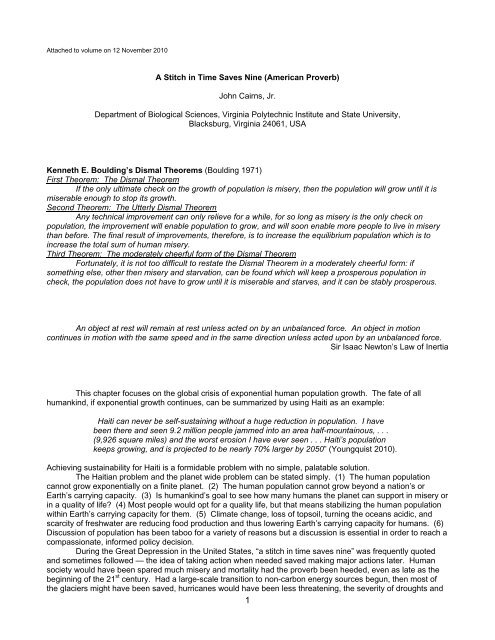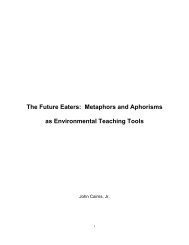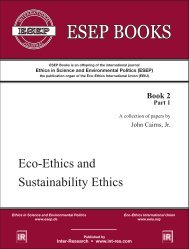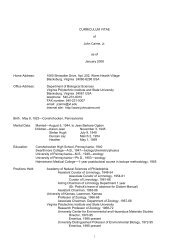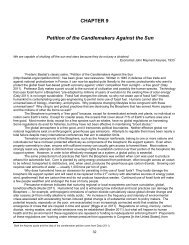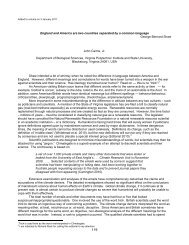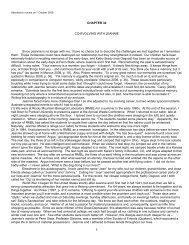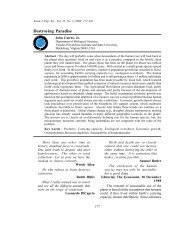A Stitch in Time Saves Nine (American Proverb) - Professor John ...
A Stitch in Time Saves Nine (American Proverb) - Professor John ...
A Stitch in Time Saves Nine (American Proverb) - Professor John ...
Create successful ePaper yourself
Turn your PDF publications into a flip-book with our unique Google optimized e-Paper software.
Attached to volume on 12 November 2010A <strong>Stitch</strong> <strong>in</strong> <strong>Time</strong> <strong>Saves</strong> N<strong>in</strong>e (<strong>American</strong> <strong>Proverb</strong>)<strong>John</strong> Cairns, Jr.Department of Biological Sciences, Virg<strong>in</strong>ia Polytechnic Institute and State University,Blacksburg, Virg<strong>in</strong>ia 24061, USAKenneth E. Bould<strong>in</strong>g’s Dismal Theorems (Bould<strong>in</strong>g 1971)First Theorem: The Dismal TheoremIf the only ultimate check on the growth of population is misery, then the population will grow until it ismiserable enough to stop its growth.Second Theorem: The Utterly Dismal TheoremAny technical improvement can only relieve for a while, for so long as misery is the only check onpopulation, the improvement will enable population to grow, and will soon enable more people to live <strong>in</strong> miserythan before. The f<strong>in</strong>al result of improvements, therefore, is to <strong>in</strong>crease the equilibrium population which is to<strong>in</strong>crease the total sum of human misery.Third Theorem: The moderately cheerful form of the Dismal TheoremFortunately, it is not too difficult to restate the Dismal Theorem <strong>in</strong> a moderately cheerful form: ifsometh<strong>in</strong>g else, other then misery and starvation, can be found which will keep a prosperous population <strong>in</strong>check, the population does not have to grow until it is miserable and starves, and it can be stably prosperous.An object at rest will rema<strong>in</strong> at rest unless acted on by an unbalanced force. An object <strong>in</strong> motioncont<strong>in</strong>ues <strong>in</strong> motion with the same speed and <strong>in</strong> the same direction unless acted upon by an unbalanced force.Sir Isaac Newton’s Law of InertiaThis chapter focuses on the global crisis of exponential human population growth. The fate of allhumank<strong>in</strong>d, if exponential growth cont<strong>in</strong>ues, can be summarized by us<strong>in</strong>g Haiti as an example:Haiti can never be self-susta<strong>in</strong><strong>in</strong>g without a huge reduction <strong>in</strong> population. I havebeen there and seen 9.2 million people jammed <strong>in</strong>to an area half-mounta<strong>in</strong>ous, . . .(9,926 square miles) and the worst erosion I have ever seen . . . Haiti’s populationkeeps grow<strong>in</strong>g, and is projected to be nearly 70% larger by 2050” (Youngquist 2010).Achiev<strong>in</strong>g susta<strong>in</strong>ability for Haiti is a formidable problem with no simple, palatable solution.The Haitian problem and the planet wide problem can be stated simply. (1) The human populationcannot grow exponentially on a f<strong>in</strong>ite planet. (2) The human population cannot grow beyond a nation’s orEarth’s carry<strong>in</strong>g capacity. (3) Is humank<strong>in</strong>d’s goal to see how many humans the planet can support <strong>in</strong> misery or<strong>in</strong> a quality of life? (4) Most people would opt for a quality life, but that means stabiliz<strong>in</strong>g the human populationwith<strong>in</strong> Earth’s carry<strong>in</strong>g capacity for them. (5) Climate change, loss of topsoil, turn<strong>in</strong>g the oceans acidic, andscarcity of freshwater are reduc<strong>in</strong>g food production and thus lower<strong>in</strong>g Earth’s carry<strong>in</strong>g capacity for humans. (6)Discussion of population has been taboo for a variety of reasons but a discussion is essential <strong>in</strong> order to reach acompassionate, <strong>in</strong>formed policy decision.Dur<strong>in</strong>g the Great Depression <strong>in</strong> the United States, “a stitch <strong>in</strong> time saves n<strong>in</strong>e” was frequently quotedand sometimes followed — the idea of tak<strong>in</strong>g action when needed saved mak<strong>in</strong>g major actions later. Humansociety would have been spared much misery and mortality had the proverb been heeded, even as late as thebeg<strong>in</strong>n<strong>in</strong>g of the 21 st century. Had a large-scale transition to non-carbon energy sources begun, then most ofthe glaciers might have been saved, hurricanes would have been less threaten<strong>in</strong>g, the severity of droughts and1
floods would have been dim<strong>in</strong>ished, and agricultural productivity would have been less threatened by climatechanges.Arguably, a major factor <strong>in</strong> the cont<strong>in</strong>u<strong>in</strong>g damage of natural systems is the low level of scientific literacyglobally and particularly <strong>in</strong> countries (e.g., the United States) with a very high per capita consumption ofresources. The oceans, which comprise about 70% of the planet’s surface area, have been changed frommildly alkal<strong>in</strong>e to mildly acidic. These changes profoundly and adversely affect mar<strong>in</strong>e ecosystems. Markedlyreduc<strong>in</strong>g carbon dioxide emissions from fossil fuel emissions just a decade or two ago would have avoided thiscatastrophe.S<strong>in</strong>ce a large number of species have become ext<strong>in</strong>ct, restoration of damaged ecosystems isproblematic s<strong>in</strong>ce species are the basic operational units of the biosphere. Ecosystems are self ma<strong>in</strong>ta<strong>in</strong><strong>in</strong>g aslong as biodiversity (i.e., replacement species) rema<strong>in</strong>s high and as long as change (e.g., global warm<strong>in</strong>g)rema<strong>in</strong>s with<strong>in</strong> the normal range of variability. However, humank<strong>in</strong>d is caus<strong>in</strong>g so many changes that thepresent era has been termed the Anthropocene. The climate changes that have already occurred makeecological restoration even more difficult. Of course, <strong>in</strong> evolutionary time (probably millions of years),biodiversity will doubtless be restored as it was follow<strong>in</strong>g the five great ext<strong>in</strong>ctions that have already happened;however, this possibility is not comfort<strong>in</strong>g to most humans now alive. This situation markedly lowers carry<strong>in</strong>gcapacity has negative effects upon the economy due to a decrease <strong>in</strong> natural resources.Failure to provide regular ma<strong>in</strong>tenance for societal <strong>in</strong>frastructures has markedly <strong>in</strong>creased the risks forboth human society and ecosystems. Ecosystems have been self ma<strong>in</strong>ta<strong>in</strong><strong>in</strong>g for billions of years. They aredynamic (e.g., species successional processes), but they do ma<strong>in</strong>ta<strong>in</strong> both structure and function unless placed<strong>in</strong> disequilibrium by some catastrophic event (e.g., the massive British Petroleum oil leak <strong>in</strong> the Gulf of Mexico <strong>in</strong>2010)Much of the <strong>in</strong>frastructure <strong>in</strong> the United States (e.g., bridges, roads, water delivery and sewage disposalsystems, dams, build<strong>in</strong>gs) is unsafe and badly needs repair or replacement. These factors are critical <strong>in</strong>determ<strong>in</strong><strong>in</strong>g carry<strong>in</strong>g capacity. Surely Homo sapiens is capable of fac<strong>in</strong>g these problems head on. Commonsense dictates that all human artifacts require cont<strong>in</strong>ual ma<strong>in</strong>tenance to rema<strong>in</strong> functional. Deterioration isusually so rapid that responsibility cannot be passed on to future generations as debt responsibilities are (e.g.,the national debt).“ . . . political forces that resist attempts to regulate greenhouse gas emissions” lead to technological<strong>in</strong>ertia that exacerbates the threat of climate change (Freedman 2010). Scientists have estimated “an 85%chance of population gr<strong>in</strong>d<strong>in</strong>g to a halt by 2100, and a 60% chance that it will not exceed 10 billion” (Connor2010). These estimates are not comfort<strong>in</strong>g s<strong>in</strong>ce about 1 billion people go to bed hungry at present.Some actions give reasons for hope. Ch<strong>in</strong>a has tried to limit couples to one child with some success.“Philipp<strong>in</strong>o President Benigno Aqu<strong>in</strong>o announced . . . [<strong>in</strong> October 2010] that his government will provide birthcontrol to poor couples to help curb the country’s high birth rate” (Reader Posted 2010). However, populationgrowth will probably cont<strong>in</strong>ue to be exponential and is only one of eight <strong>in</strong>teractive global crises (Cairns 2010).The 21 st century will be a rough era for humans because natural resources are decl<strong>in</strong><strong>in</strong>g and the populationcont<strong>in</strong>ues to grow.Acknowledgments. I am <strong>in</strong>debted to Darla Donald for transcrib<strong>in</strong>g the handwritten draft and for editorialassistance <strong>in</strong> preparation for publication and to Paul Ehrlich and Paula Kullberg for call<strong>in</strong>g useful references tomy attention.LITERATURE CITEDBould<strong>in</strong>g, K. 1971. Collected Papers [by] Kenneth E. Bould<strong>in</strong>g, Vol. 2. Colorado Associated University Press,Boulder, CO, p. 137.Cairns, J., Jr. 2010. Threats to the biosphere: eight <strong>in</strong>teractive global crises. Journal of Cosmology 8:1906-1915.Connor, S. 2010. World population forecast to peak before 2100. The Independent 2Aughttp://www.<strong>in</strong>dependent.co.uk/news/science/world-population-forecast-to-peak-before-2100-664281.html.Freedman, A. 2010. Tomorrow’s <strong>in</strong>frastructure poses greater climate threat than today’s, study f<strong>in</strong>ds. ClimateCentral 10Septhttp://climatecentral.org/break<strong>in</strong>g/news/tomorrows_<strong>in</strong>frastructure_poses_greater_climate_threat_than_todays_study_f<strong>in</strong>ds.Reader Posted. 2010. The politics of birth control. 28Sept RH Reality Checkhttp://www.rhrealitycheck.org/reader-diaries/2010/09/28/politics-birth-control.2


